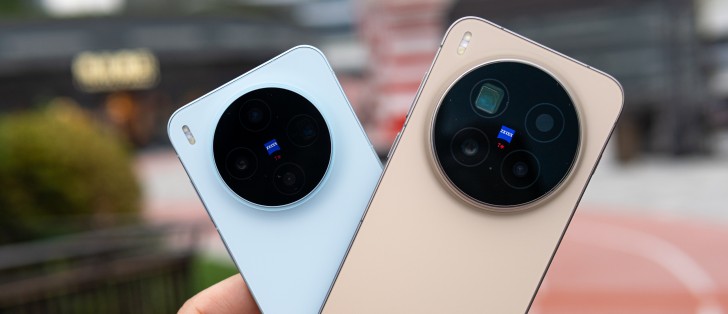Representation
Vivo’s X300 series has come, and it brings a large flagship X300 Pro and compact flagship to the X300. This shows a new approach by Vivo, which is 30 years by the way, the equivalent of the X200 and X200 Pro, as well as the X200 Pro mini, in only one go, with only two phones.
The new, ‘All Big Core’ Dimensity 9500 – SOC has a 3NM powerhouse, forcing the X300 phone to Antutu 11 scores ahead of 4 million.

While last year the X200 struggled to identify in the shadow of a better well-equipped X200 Pro, despite the same size, this year the X300 made a lot of meaning as a 6.31-inch phone. It is the same with the pro in terms of display and battery technology, design and build and processing feat, but lacks in terms of camera performance all around. Referring to it on stage during the projection in China, all of them were often called the X300 Pro Mini, which gives you an idea of what Vivo aimed here.
The small phone uses the same 1/1.4-inch 200MP isosel HPB sensor for its main camera for its main camera, which is an upgrade marked at 1/1.56-inch 50MP of X200. It also bumps up to 32MP selfie up to 50MP (again, it is the same for X300 Pro). The remaining camera is similar to last year’s X200, if not the same-you get 15 mm f/2.0 ultravide with 70mm f/2.6 and 1/2.76-inch imager against 1/1.95-inch sensor.

But the biggest story here is a more compact body. Fans of small flagship phones would like the new X300. It only reaches 151 mm tall, 72 mm wide and only 8 mm thick. It also measures only 190 grams. The body is flat on the front and back, and has matte flat sides. You can arrange the Vivo X300 in some interesting colors like blue, purple, pink (which has interesting colors) and red.
At a glance Vivo X300 Specs:
- Organization 150.6×71.9×8.0 mm, 190g; Glass front, aluminum alloy frame, glass back; IP 68/IP69 Dust tight and water resistant (high pressure water jets; dipping up to 1.5 m for 30 minutes).
- Exhibition: 6.31 “LTPO AMOLED, 1B Colors, 120 Hz, 2160 Hz PWM, HDR 10+, HDR Vivid, 4500 NITS (Pick), 1216x2640PX Resolution, 19.54: 9 aspect ratio, 460 PPI;
- Chipset: MediaTek Demensity 9500 (3 Nm): Octa-core (1×4.21 GHz C1-Altra and 3×3.5 GHz C1-Promium and 4×2.7 GHz C1-Pro); Arm G1-Altra.
- Memory: 256 GB 12GB RAM, 256 GB 16GB RAM, 512 GB 12 GB RAM, 512 GB 16GB RAM, 1 TB 16 GB RAM; UFS 4.1.
- OS/S. SOFTWARE FIRTWARE: Android 16, 4 Major Android Upgrades, Forn 16 (International), Original 6 (China).
- Rear Camera: Huge (main): 200 MPs, F/1.7, 23 mm, 1/1.4 “, 0.56µm, PDAF, OIS; Telephoto: 50 MP, F/2.6, 70 mm, 1/1.95 “, PDAF, OIS, 3X optical zoom; Several widths: 50 MP, F/2.0, 15 mm, 119˚, 1/2.76 “, 0.64µm, AF.
- Front camera: 50 MPs, F/2.0, (wide), 1/2.76 “, 0.64µm, AF.
- Video Capture: Rear camera: 4K@30/60/120fps, 1080p@30/60/120/220fps, gears-EIS, 4K@120 fps HDR; Front camera: 4K@30/60FPS, 1080p@30/60fps.
- Battery: 6040 mAh; 90W Word, 40 W Wireless, Reverse Wired.
- Connection: 5g; Esim; Wi-Fi 7; BT 5.4, APTX HD, LHDC 5; NFC; Infrared port.
- Abuse: Fingerprint reader (under display, ultrasonic); Stereo speakers.
The Vivo X300 Pro is a direct upgrade for its predecessor. You get an annual chipset upgrade and a more pure body. The phone is a bit thin at 8 mm. The X300 Pro is just as flat as the X300 on the front and rear but unlike small phones, it always has a very curved 3D glass edge where the glass meets the frame. The frame is no longer a glossy finish, but a matte.

The camera system has also been purified, though on the surface, it looks the same. Vivo says 85mm f/2.67 Zeiss APO Telefoto camera is all new. On the surface, 85 mm f/2.67 is exactly the same as the X200 Pro, but on the X300 Pro uses the zoom isosel HPB, a customized HP9 variant co-developed between Vivo and Samsung. It is the result of a two -year collaboration between the two giants. HPB Monica is used for ‘HP9 Blue “, but it was not clear how different from the regular HP 9 found in Vivo X 200 Pro.
At a glance Vivo X300 Pro Specs:
- Organization 161.2×75.5×8.0 mm, 226g; Glass front, aluminum alloy frame, glass back; IP 68/IP69 Dust tight and water resistant (high pressure water jets; dipping up to 1.5 m for 30 minutes).
- Exhibition: 6.78 “LTPO AMOLED, 1B colors, 120 Hz, 2160 Hz PWM, HDR 10+, HDR Vivid, Dolby Vision, 4500 NITS (Pick), 1260x2800px Resolution, 20: PPI; Ultra HDR.
- Chipset: MediaTek Demensity 9500 (3 Nm): Octa-core (1×4.21 GHz C1-Altra and 3×3.5 GHz C1-Promium and 4×2.7 GHz C1-Pro); Arm G1-Altra.
- Memory: 256 GB 12GB RAM, 512 GB 16GB RAM, 1 TB 16 GB RAM; UFS 4.1.
- OS/S. SOFTWARE FIRTWARE: Android 16, 4 Major Android Upgrades, Forn 16 (International), Original 6 (China).
- Rear Camera: Huge (main): 50 MP, F/1.6, 24 mm, 1/1.28 “, 1.22µm, PDAF, OIS; Telephoto: 200MP, F/2.7, 85 mm, 1/1.4 “, 0.56µm, multi-directional PDAF, OIS, 3.7X optical zoom, macro 2.7: 1; Several widths: 50 MP, F/2.0, 15 mm, 119˚, 1/2.76 “, 0.64µm, AF.
- Front camera: 50 MPs, F/2.0, (wide), 1/2.76 “, 0.64µm, AF.
- Video Capture: Rear camera: 8 K@30 fps, 4k@30/60/120fps, 1080p@30/60/220FPS, Gyes-EIS, 4 K@120 fps 10-bit log, Dolby Vision HDR; Front camera: 4K@30/60FPS, 1080p@30/60fps.
- Battery: 6510 mAh; 90W Word, 40W wireless, reverse wireless, reverse wired.
- Connection: 5g; Esim; Wi-Fi 7; BT 5.4, APTX HD, LHDC 5; NFC; Infrared port.
- Abuse: Fingerprint reader (under display, ultrasonic); Stereo speakers; Satellite connectivity support (optional, market/field based).
Both phones use new silicon anode tech batteries-they are their 4th General Tech and 2nd General Semi-Solid-State Battery. The large X300 Pro has a 6,510 mAh cell, while the X300 has a 6,040 mAh unit. Vivo says Software Ftware and Hardware Progress Joins to deliver battery endurance equivalent to 7,500 mAh and 7,000 mAh batteries on other phones. His performance in the cold is also impressive and one of the we saw was a phone that sat in a block of snow and operated for hours without any issues.
After all, Vivo’s original 6 sits on the helm of a new series. It has a new translucent design, a new engine, and has been entrusted with the best of the new dementia 9500. Vivo says they have rebuilt Android from the ground for better battery efficiency and performance. Innovations such as ultra-core computing, dual rendering and memory fusion ensures that the all-big-core chip offers the best possible performance.






